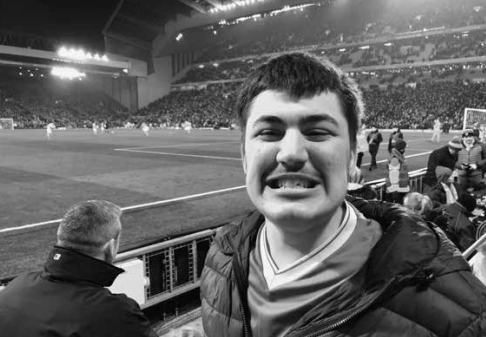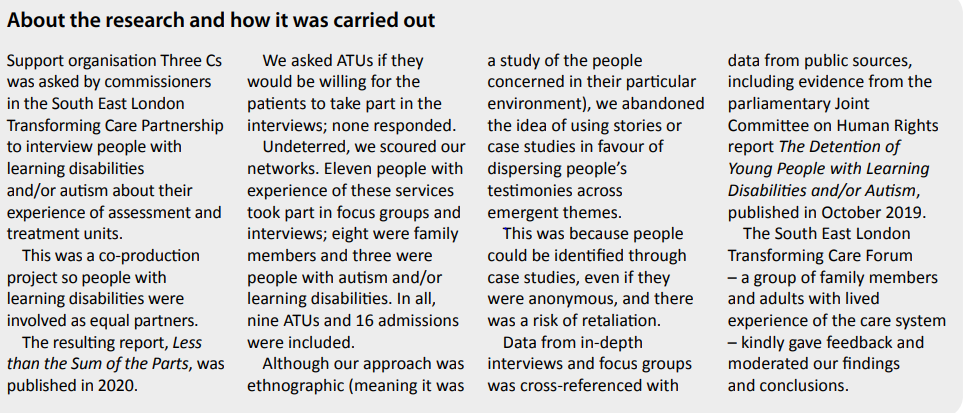Assessment and treatment units have long been the antithesis of a place of safety, with a high incidence of injury, restraint, abuse and neglect of basic healthcare. Their very model of care is actively harmful and creates the conditions for human rights abuses, says Jo Clare
The findings of an investigation into assessment and treatment units (ATUs) were shocking, damning – and completely unsurprising.
The research – Less Than the Sum of its Parts – was carried out by support organisation Three Cs for health commissioning groups in London. The findings mirrored exactly the evidence – which is already out there and has been out there for more than 20 years – of perilous and fatal health inequalities. These were highlighted in Mencap’s Treat Me Right in 2004 and Death by Indifference three years later, the review by Mazars into deaths in hospital of people with mental health problems and learning disabilities and the Learning Disabilities Mortality Review (LeDer) reports.
Harrowing individual stories have been relived in Sara Ryan’s Justice for Laughing Boy published in 2015, the Rightfullives exhibition held in 2018 and Alexis Quinn’s Unbroken, published last year. Disturbing stories have been shared daily, with deep anguish and fury, on social media for years. Our study, like the stories out there, was also compelling about how different the lives of adults and children with learning disabilities and/or autism can be if only we do the right things at the right time in the right, personalised way for each individual child or adult and their families.
Controlled, risky culture
The now infamous “closed culture” – a characteristic of abusive settings that is now being targeted by Care Quality Commission inspectors after it learned its lessons from Whorlton Hall – made itself felt from the start. None of the 59 ATUs or inpatient services approached responded to our request to enable patients to take part in the study. This was a stark reminder that providers control patient access and patient evidence.
There was evidence that the system is retaliatory and bullying made it imperative to conceal identities. Speaking out against mistreatment put people at risk of being sectioned again; if families complained about the treatment of a loved one, the psychiatrist might threaten to send the person to a unit hundreds of miles away. And, if you write a research report that names the worst and most litigious offenders, you risk that it will not see the light of day.
Whole system fails
In a nutshell, we concluded that the clinical and moral incoherence of the ATU model actively creates the conditions for human rights abuses.
Paving the way to the ATU door is a whole-system deficit in timely and appropriate support for children and adults with learning disabilities and/or autism – especially at points of life transition and crisis. Underpinning this failure is an outmoded Mental Health Act, an incompetent medical model of care and a hierarchy of expertise in which those with learning disabilities and/or autism – and their families – are firmly at the bottom.
Some former inpatients were already enjoying good, ordinary lives with personalised support and community-based interventions and treatment, giving the lie to the pernicious notion that there was “nowhere else” for them to go. The most populous theme arising from the interviews, and thence the biggest chapter, was “system culture and human rights”. There was significant evidence of breach or risk of breach of six articles under the Human Rights Act.
This included the right to life (article 1) with near misses on overdose, infection and dangerous neglect of known underlying health conditions, including allergy. The precept of no torture, inhumane or degrading treatment (article 2) was challenged with injurious use of physical restraint, resulting in injuries including a broken arm and broken clavicle, solitary confinement in small cells for long periods, disrespect for people’s clothes and possessions, no support for personal care, no privacy when using the toilet, caged transport for a child and concerns about starvation.
A harmful model of care is an inarguable paradox, makes no clinical sense and is unethical. Many ATUs are the antithesis of a place of safety, with an untenably high incidence of distress, injury caused by a combination of detention, seclusion, physical and chemical restraint, abuse and neglect of basic healthcare, the last leading to deaths from manageable conditions such as epilepsy and constipation. Short periods of assessment turn into an average of 5.4 years detention, according to Mencap; for our research cohort, this was an average of two years and nine months.
It is hard to imagine how such a calamitous intervention passes the NHS threshold for funding evidence-based treatment.
Treatment of no therapeutic value
While ATUs are intended to assess and treat people, their primary methods – detention, segregation, seclusion and restraint – have no therapeutic value whatsoever. As well as being liable to cause injury and distress, they deprive patients of the psychosocial aspects of existence (sleeping well, eating well, meaningful activity, exercising and spending time with friends and family) that are known to keep children and adults healthy and mentally well.
Since psychosocial deprivation is known to be among the primary triggers for so-called “challenging behaviour”, it is not surprising that ATUs can cause or intensify the mental health conditions and behaviour they are intended to assess and treat. If communication and understanding patient needs are at the heart of the inpatient experience, then understanding an individual’s experience of autism and their highly persona style of communication is critical.
If this is largely absent, as it was in our study, it explains why patients receive inferior physical healthcare and are at risk of dying from treatable conditions. It also calls into question how mental illness can ever be accurately diagnosed or excluded in this group of patients. Detention with open-ended assessment and no effective treatment was experienced as punishment akin to imprisonment, with seclusion and segregation the equivalent of solitary confinement. This was compounded in some institutions with small prison-like cells, dark airless wards and a complete absence of personalisation and home comforts.
Placing people hundreds of miles away from their friends and families, regularly cancelling family visits and section 17 leave all compromise article 8 – the right to a private and family life.
If people with learning disabilities and/or autism are subjected to detention in such places when they have no treatable mental health conditions, when assessment is obscured by behaviours of concern, when treatment has no therapeutic value, this is surely a state-sponsored subversion of not only article 5 (the right to liberty) but also article 6 (the right to a fair hearing) and article 7 (no punishment without law).

Financial incentives
The second big paradox is economic. The study found cost shunting and funding battles between health and social care were frequently implicated in delays that caused or exacerbated crises, defeated successful discharge and delayed resettlement.
Yet money and repeat funding appear to be no object when someone is in the system. If an ATU charges £13,500 per week, as was the case for one of our witnesses, it is set to bring in £3.8 million per person over the average 5.4 years’ detention. This is money that could so obviously be spent on an ordinary life and more effective treatment in the community, instantly ending the “nowhere else to go” argument.
On this basis, this is potentially a guaranteed £1.4 billion per annum industry for detaining 2,000 people still stranded in inpatient settings at the end of the failed Transforming Care programme. While my back-of-an-envelope financial assumptions may be challenged, the business model is clear: serial sectioning is effectively repeat business and there is a perverse, pecuniary incentive to detain people – and to keep detaining them.
Next time there is a scandal in the private or not-for-profit sector, instead of focusing just on the reprehensible actions of criminal staff, look towards the top of the food chain, at the business model and structure that holds this culture of abuse in place and at a government that appears happy to aid and abet it by its inaction. Better surveillance? Better training? Safer methods of restraint? Such continuous improvement fixes are a shoal of dazzling red herrings, distracting us from the wreck of this model, obscuring the sharks lurking in the murky, mendacious depths below.
Instead, let us shine a light on vested interests like dividends to shareholders, remuneration of executives and non-executives, fees of consultant psychiatrists, lawyers, lobbyists and the whole panoply of defensive and offensive tactics that some providers use to defend their share of this lucrative market.
If ATUs trash the rights and trade in the lives and liberty of children and adults with learning disabilities and/or autism, they must surely be stopped, not improved.
Less than the Sum of its Parts is available at https://tinyurl.com/y42t875y;
the easy read version is at https://tinyurl.com/yawbjcyv





